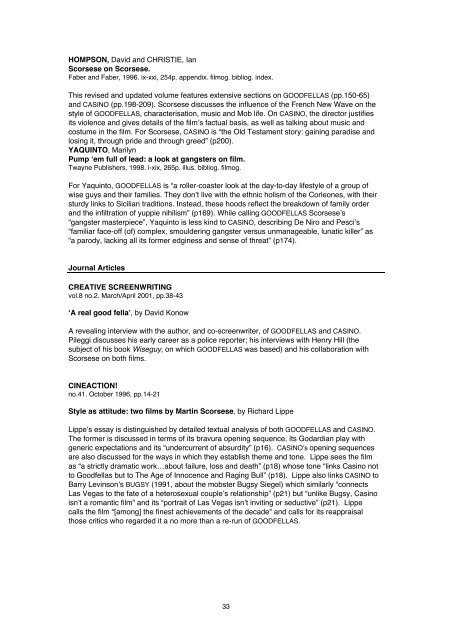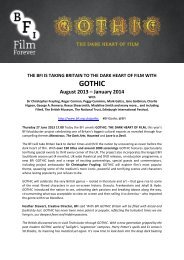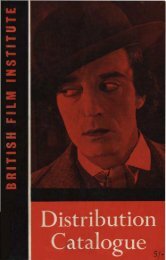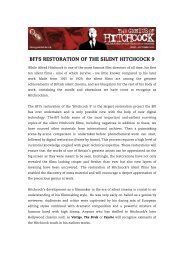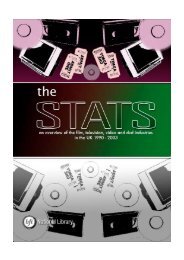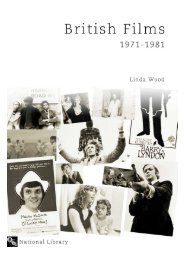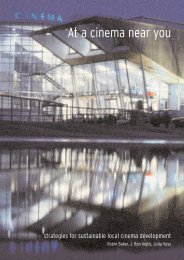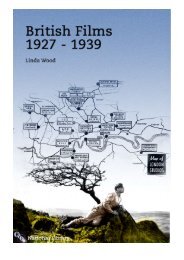16 + GUIDE - British Film Institute
16 + GUIDE - British Film Institute
16 + GUIDE - British Film Institute
Create successful ePaper yourself
Turn your PDF publications into a flip-book with our unique Google optimized e-Paper software.
HOMPSON, David and CHRISTIE, Ian<br />
Scorsese on Scorsese.<br />
Faber and Faber, 1996. ix-xxi, 254p. appendix. filmog. bibliog. index.<br />
This revised and updated volume features extensive sections on GOODFELLAS (pp.150-65)<br />
and CASINO (pp.198-209). Scorsese discusses the influence of the French New Wave on the<br />
style of GOODFELLAS, characterisation, music and Mob life. On CASINO, the director justifies<br />
its violence and gives details of the film’s factual basis, as well as talking about music and<br />
costume in the film. For Scorsese, CASINO is “the Old Testament story: gaining paradise and<br />
losing it, through pride and through greed” (p200).<br />
YAQUINTO, Marilyn<br />
Pump ‘em full of lead: a look at gangsters on film.<br />
Twayne Publishers, 1998. i-xix, 265p. illus. bibliog. filmog.<br />
For Yaquinto, GOODFELLAS is “a roller-coaster look at the day-to-day lifestyle of a group of<br />
wise guys and their families. They don’t live with the ethnic holism of the Corleones, with their<br />
sturdy links to Sicilian traditions. Instead, these hoods reflect the breakdown of family order<br />
and the infiltration of yuppie nihilism” (p<strong>16</strong>9). While calling GOODFELLAS Scorsese’s<br />
“gangster masterpiece”, Yaquinto is less kind to CASINO, describing De Niro and Pesci’s<br />
“familiar face-off (of) complex, smouldering gangster versus unmanageable, lunatic killer” as<br />
“a parody, lacking all its former edginess and sense of threat” (p174).<br />
Journal Articles<br />
CREATIVE SCREENWRITING<br />
vol.8 no.2. March/April 2001, pp.38-43<br />
‘A real good fella’, by David Konow<br />
A revealing interview with the author, and co-screenwriter, of GOODFELLAS and CASINO.<br />
Pileggi discusses his early career as a police reporter; his interviews with Henry Hill (the<br />
subject of his book Wiseguy, on which GOODFELLAS was based) and his collaboration with<br />
Scorsese on both films.<br />
CINEACTION!<br />
no.41. October 1996, pp.14-21<br />
Style as attitude: two films by Martin Scorsese, by Richard Lippe<br />
Lippe’s essay is distinguished by detailed textual analysis of both GOODFELLAS and CASINO.<br />
The former is discussed in terms of its bravura opening sequence, its Godardian play with<br />
generic expectations and its “undercurrent of absurdity” (p<strong>16</strong>). CASINO’s opening sequences<br />
are also discussed for the ways in which they establish theme and tone. Lippe sees the film<br />
as “a strictly dramatic work…about failure, loss and death” (p18) whose tone “links Casino not<br />
to Goodfellas but to The Age of Innocence and Raging Bull” (p18). Lippe also links CASINO to<br />
Barry Levinson’s BUGSY (1991, about the mobster Bugsy Siegel) which similarly “connects<br />
Las Vegas to the fate of a heterosexual couple’s relationship” (p21) but “unlike Bugsy, Casino<br />
isn’t a romantic film” and its “portrait of Las Vegas isn’t inviting or seductive” (p21). Lippe<br />
calls the film “[among] the finest achievements of the decade” and calls for its reappraisal<br />
those critics who regarded it a no more than a re-run of GOODFELLAS.<br />
33


